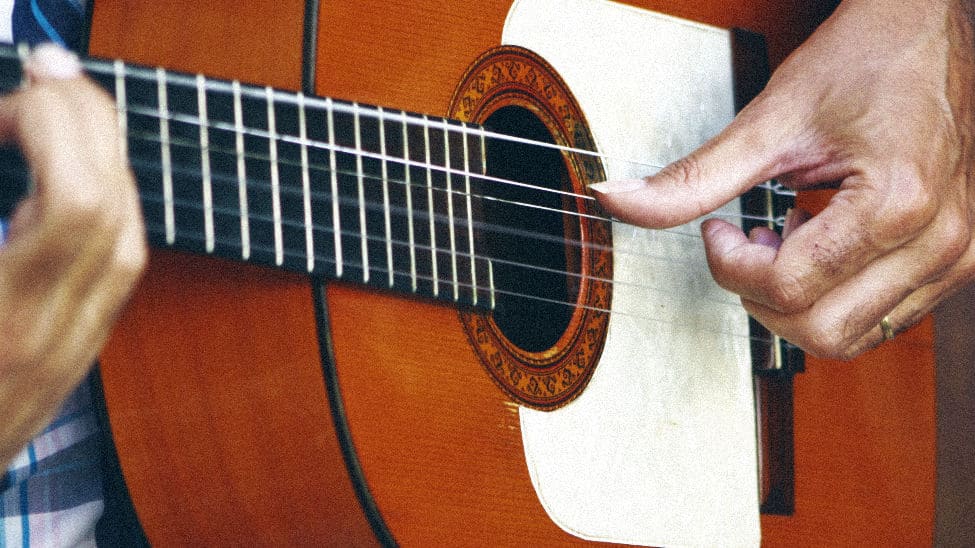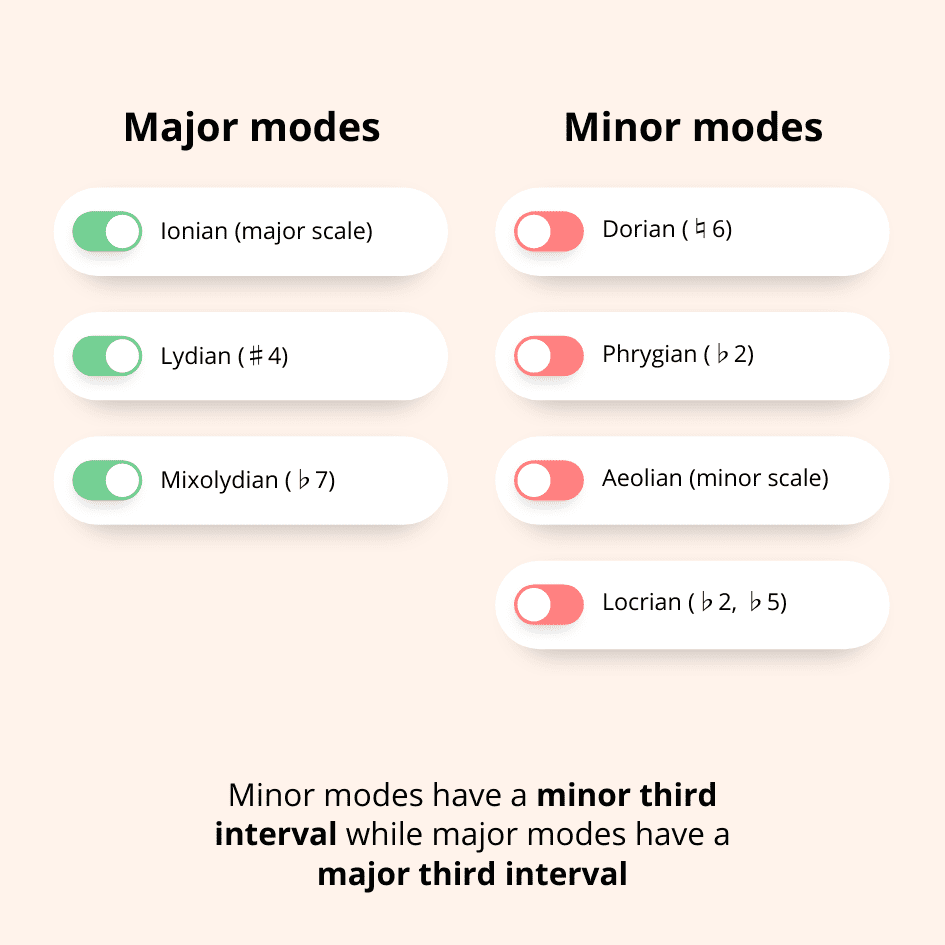
The Phrygian mode is admittedly one of the more “niche” musical modes, but it’s an absolute weapon for evoking Latin, Middle Eastern, or unsettling minor key vibes in your productions.
This post is part of an ongoing series on musical modes, what they are, how they work, and how they can enhance your music.
In this article, we’re zooming in on the Phrygian mode.
We’ll talk about:
- What the Phrygian mode is and how to use it
- What the Phrygian mode “feels” like in music
- Examples of the Phrygian mode across multiple genres and mediums
This is gonna be fun. But first, let’s do quick review on modes as a whole.
Table of Contents
What are musical modes and why are they important?
Musical modes are particular ways to organize musical pitches, not unlike a scale.
Modes are important because they can help us break out of the “major is happy” and “minor is sad” clichés, and allow us to express more nuanced emotions in our music.
In the Western classical tradition, there are seven primary modes, often referred to as diatonic modes (click to read my article on each one):
- Ionian
- Dorian
- Phrygian
- Lydian
- Mixolydian
- Aeolian
- Locrian
Many folks will describe modes as just “major scales with different starting notes.” For example, if you take the C major scale…
C – D – E – F – G – A – B – C
…and shift the starting note (tonic) to the third degree, you would construct a scale in the E Phrygian mode:
E – F – G – A – B – C – D – E
It’s all the same notes, just shifted over one degree.
This is all well and good, but I don’t think it lends itself well to really learning and internalizing modes (or transposing modes into any other key besides C, because that’s always the one used in these examples).
A better way is to think of modes in two camps: major modes and minor modes.
Major modes are all the modes with a major third, namely:
- Ionian (classic major scale)
- Lydian
- Mixolydian
While minor modes are all the modes with a minor third:
- Dorian
- Phrygian
- Aeolian (classic minor scale)
- Locrian
You can think of each mode as a twist or variation of the standard major or minor scale. In our case, we’re focusing on the Phrygian mode, which is technically just a minor scale with a flattened second.

That’s it! To me, that’s so much easier to remember and understand than the mental gymnastics of figuring out my starting note for whatever key I’m in.
What is the Phrygian mode?
The Phrygian mode, as we’ve just described, is a minor scale with a flattened second degree.
So, to put a finer point on it, here is an E minor scale (which we could call an Aeolian mode). It’s just your standard, A-grade, farm-raised, gluten-free minor scale:
E – F# – G – A – B – C – D – E
Notice the major second interval, the F#.

Now, this is our E Phrygian mode (remember, just an E minor scale with a flattened second):
E – F – G – A – B – C – D – E

Do you hear the difference? It took the already dark minor scale and it made feel even darker. It’s less sad and more unsettling.
What does the Phrygian mode “feel” like?
Believe it or not, the Phrygian mode is the go-to mode for a lot of Latin music, most notably Flamenco. Listen to the opening few chords of this performance:
That Em – F – G progression is one of the most distinctly Latin sounds, and it’s all thanks to the Phrygian mode.
But the Phrygian mode isn’t just relegated to this particular genre. It’s also used in pop music, hip-hop, and film scores to evoke a deep sense of weight and gravitas.
This is largely due to the minor second interval between our root note and the flattened 2nd degree of the scale. A minor second is one of the most “crunchy” or dissonant sounds in Western music (perhaps second only to the tritone).
Try it out on piano. Simultaneously play two keys that are directly next to each other. Pretty spicy, eh?
We’ll look at some real life examples later in this post.
How Phrygian harmony changes the vibe of your music
The Phrygian mode, when applied to your harmony, will also change the quality (major or minor) of certain chords. This can lead to really interesting harmonic progressions that fall outside of a typical diatonic range.
To review, if we were to build triads on each of the chords in the E minor scale, we’d have these chords at our disposal:

However, because of our flattened second in the Phrygian mode, a few of our chords are altered. Take a look (and listen):

Let’s take a look at what’s going on here.
Notice that the Phrygian mode has altered three of our triads:
- The F#° turns into an F major (this is probably the most drastic shift)
- The Bm turns into a B°
- And the D major turns into a Dm
It’s worth noting that you don’t need to stick to just these chords prescriptively. You can oscillate back and forth between a natural minor scale and the Phrygian mode (or any other mode) whenever you want. It’s a free country!
This is called mode mixture, and it happens all the time in every type of music.
Here’s a video of Rick Beato demonstrating how the Phrygian mode can evoke deep, dissonant gravitas in the context of film scoring:
How to use the Phrygian mode in your music
Now that we know how the Phrygian mode is constructed, and what it “sounds” like, let’s talk about how to use it in your music.

First off, you can use it just like any other minor scale:
- For soloing/improvising over a minor chord progression
- For composing a melody in a minor key
- For creating a deeper, “crunchier” minor feel in your music
- For evoking Latin and Flamenco vibes
Examples of the Phrygian mode
To get your creative juices flowing, let’s look at some examples of real-life music that uses the Phrygian mode.
This video by David Bennett Piano reveals some really interesting tunes that use Phrygian, including quite a few hip-hop tracks:
And of course, I can’t leave you guys without some solid video game music examples of the Phrygian mode.
Shota Kageyama uses the Phrygian mode in this track for Pokémon X & Y. Listen to how the glockenspiel in the background touches on that flattened second, and around the :23 second mark, you can even hear the bass ascend up that half step to that same pitch.
It’s a more mysterious minor vibe, and a subtly great example of the Phrygian mode in action.
A more modern example of the Phrygian mode in action is from Super Mario Odyssey. This is the track that plays when you’re in icy environments. It’s in C Phrygian, and both the melody and harmony really emphasize that C to C# crunch.
Another classic from the Nintendo all-star composers.
Final thoughts
Let’s summarize what we’ve learned:
Modes are an excellent tool for evoking more complex and nuanced emotions in your music.
The Phrygian mode is a minor scale with a flattened second. It’s perfect for creating an even more dissonant or unsettling minor scale.
Now that you understand the Phrygian mode, try using it in your own music! And if you’re looking for more information on modes, be sure to subscribe to my newsletter (by filling out the form below) so you don’t miss another article.
Thanks for reading!

Thanks for this. I LOVE Phyrgian. When I learned about modes, it quickly became my favorite for its unique sound.